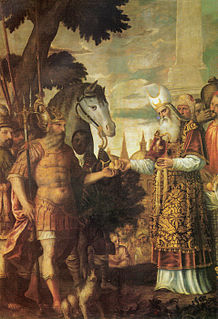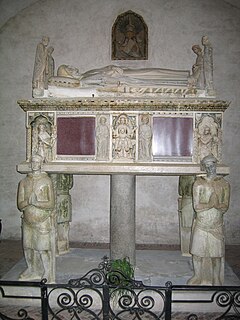
The Basilica di Santa Maria Gloriosa dei Frari, usually just called the Frari, is a church located in the Campo dei Frari at the heart of the San Polo district of Venice, Italy. One of the most prominent churches in the city, it has the status of a minor basilica. The church is dedicated to the Assumption of Mary.

Alessandro Bonvicino, more commonly known as Moretto, or in Italian Il Moretto da Brescia, was an Italian Renaissance painter from Brescia, where he also mostly worked. His dated works span the period from 1524 to 1554, but he was already described as a master in 1516. He was mainly a painter of altarpieces that tend towards sedateness, mostly for churches in and around Brescia, but also in Bergamo, Milan, Verona and Asola; many remain in the churches they were painted for. Most are on canvas, but a number even of large ones are on wood panel. Only a handful of drawings survive.

Girolamo Savoldo, also called Girolamo da Brescia was an Italian High Renaissance painter active mostly in Venice, although he also worked in other cities in northern Italy. He is noted for his subtle use of color and chiaroscuro, and the sober realism of his works, which are mostly religious subjects, with a few portraits, which are given interest by their accessories or settings, "some even look like extracts from larger narratives".

Oderzo is a town and comune in the province of Treviso, Veneto, northern Italy. It lies in the heart of the Venetian plain, about 66 kilometres to the northeast of Venice. Oderzo is traversed by the Monticano River, a tributary of the Livenza.

Santa Maria Formosa is a church in Venice, northern Italy. It was erected in 1492 under the design by Renaissance architect Mauro Codussi. It lies on the site of a former church dating from the 7th century, which, according to tradition, was one of the eight founded by San Magno, bishop of Oderzo. The name "formosa" relates to an alleged appearance of the Holy Virgin disguised as a voluptuous woman1.
The year 1516 in art involved some significant events and new works.

Italian Renaissance painting is the painting of the period beginning in the late 13th century and flourishing from the early 15th to late 16th centuries, occurring in the Italian peninsula, which was at that time divided into many political states, some independent but others controlled by external powers. The painters of Renaissance Italy, although often attached to particular courts and with loyalties to particular towns, nonetheless wandered the length and breadth of Italy, often occupying a diplomatic status and disseminating artistic and philosophical ideas.

Pietro Marone was an Italian painter of the late-Renaissance periods, mainly active in Brescia and Mantua.
Cristoforo Rosa was an Italian painter of quadratura of the Renaissance period.
The year 1522 in art involves various significant events.
The year 1554 in art involved some significant events and new works.

The da Camino were an Italian noble family whose fame is connected to the mediaeval history of the March of Treviso, a city of which they were lords for a while.
Tiziano is an Italian masculine given name, and may refer to:

The Averoldi Polyptych is a painting by the Italian late Renaissance painter Titian, dating to 1520–1522 and in the basilica church of Santi Nazaro e Celso in Brescia, northern Italy.
Saint Titian may refer to:
Giacomo Coltrini was an Italian painter, active mainly in a Renaissance style in Brescia, and a military engineer for Venetian Republic. He painted frescoes for the subterranean church of San Faustino Maggiore in Brescia. He died as a military engineer in Candia. Titian's paternal uncle, Gregorio Vecelli, lived in Coltrini's house in Venice.
This page is based on this
Wikipedia article Text is available under the
CC BY-SA 4.0 license; additional terms may apply.
Images, videos and audio are available under their respective licenses.










